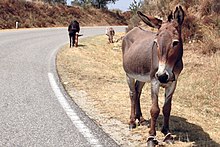Hobbles
Hobbles , in German Hobbel , (usually used in the plural ) is the term for ankle cuffs of horses . An old word for it is "Haile", which is depicted in the city arms of Bönen . They are sometimes used in open terrain when there is no other way of tying a horse, or, less often, to give the horse more freedom of movement for grazing - for example overnight - than when tying it up. There are hobbel in a wide variety of designs, from the knotted hobbel made of rawhide rope to the wide, padded hobbel made of leather.
Hobbling was particularly widespread among the cattle drovers ( cowboys , gauchos ) in America when there were large herds of cattle . During a rest, they tied the front legs of their horses with a gap of a few decimeters to prevent them from running away. The horses could take small steps and move a little and graze, but it was impossible for them to run far or gallop .
Hobbling is still used today, e.g. B. for trail rides. However, some horses soon find out how they can make hops despite being shackled and still move relatively quickly; For such horses, some riders use hobbles, which are attached to three legs of the horse and thus prevent the jumps.
A planed horse should never be left unattended. The method is not suitable for permanent fixation of the animal, as the shackles can easily damage the skin.
Horses need a certain amount of getting used to hobbling. You have to slowly learn to feel like you are being handcuffed.
Karl May often describes this type of connection in his novels about the Wild West.

